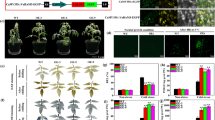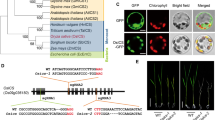Abstract
A potato (Solanum tuberosum L. ) cDNA coding for the chloroplastic isoform of fructose 1,6-bisphosphatase (cp-FBPase) was utilized to repress its activity in tomatoes (Lycopersicon esculentum Mill.) using antisense techniques. The patatin B33 promoter was used to ensure fruit specificity of the antisense effect. Transgenic plants were isolated in which fructose 1,6-bisphosphatase activity was reduced by more than 50% of the control in green fruits. Immunoblots indicated that the plastidial isoform was almost completely eliminated in the most strongly inhibited lines. Fruits of the transgenic plants were analyzed for levels of metabolites during fruit development. Glucose and fructose concentrations were increased in green fruits in the transgenic lines, but unchanged at later stages of development. The sucrose concentration was low, and was not significantly altered in the transgenic lines. There was net degradation of starch over the developmental period, but the starch content was not decreased. In green fruit the levels of hexose phosphates were unchanged, whilst the level of 3-phosphoglyceric acid was significantly increased in one line. Most importantly the deduced ratio of hexose phosphate to 3-phosphoglyceric acid decreased, consistent with an in vivo inhibition of fructose 1,6-bisphosphatase activity. One consequence of this reduction of in vivo activity of cp-FBPase was that the average weight of fully ripe fruits was significantly decreased by up to 20% in all transgenic lines in comparison with the control.


Similar content being viewed by others
Abbreviations
- AGPase :
-
ADP-glucose pyrophosphorylase
- cp-FBPase :
-
Chloroplastidic fructose 1,6-bisphosphatase
- cy-FBPase :
-
Cytoplasmic fructose 1,6-bisphosphatase
- DAF:
-
Days after flowering
References
Akhtar MS, Goldschmidt EE, John I, Rodoni S, Matile P, Grierson D (1999) Altered pattern of senescence and ripening in gf, a stay-green mutant of tomato (Lycopersicon esculentum Mill.). J Exp Bot 50:1115–1122
Bhattacharrya MK, Smith AM, Ellis THN, Hedley C, Martin C (1990) The wrinkled-seed character of pea described by Mendel is caused by a transposon-like insertion in a gene encoding starch branching enzyme. Cell 60:115–121
Bradford MM (1976) Rapid and quantitative method for the quantitation of microgram quantities of protein utilizing the principle of protein-dye binding. Anal Biochem 72:248–252
Büker M, Schünemann D, Borchert S (1998) Enzymic properties and capacities of developing tomato (Lycopersicon esculentum L.) fruit plastids. J Exp Bot 49:681–691
Fernie AR, Roscher A, Ratcliffe RG, Kruger NJ (2001). Fructose 2,6-bisphosphate activates pyrophosphate: fructose 6-phosphate 1-phosphotransferase and increases triose phosphate to hexose phosphate cycling in heterotrophic cells. Planta 212:250–263
Fernie AR, Willmitzer L, Trethewey RN (2002) Sucrose to starch: a transition in molecular plant physiology. Trends Plant Sci 7:35–41
Frommer WB, Mielchen C, Martin T (1994) Metabolic control of patatin promoters from potato in transgenic tobacco and tomato plants. Plant Physiol (Life Sci Adv) 13:329–334
Hagelin K, Rodriguez-Suarez R, Katzen F, Wolosiuk RA, Baldi PC, Giambartolomej GH, Fossati CA, Dyer T (1996) Interspecies cross-reactivity of a monoclonal antibody directed against wheat chloroplast fructose-1,6-bisphosphatase. Cell Mol Biol 42:673–682
Kammerer B, Fischer K, Hilpert B, Schubert S, Gutensohn M, Weber A, Flügge U-I (1998) Molecular characterization of a carbon transporter in plastids from heterotrophic tissues: the glucose 6-phosphate/phosphate antiporter. Plant Cell 10:105–117
Kossmann J, Lloyd JR (2000) Understanding and influencing starch biochemistry. Crit Rev Plant Sci 19:171–226
Kossmann J, Müller-Röber B, Dyer TA, Raines CA, Sonnewald U, Willmitzer L (1992) Cloning and expression analysis of the plastidic fructose 1,6-bisphosphatase coding sequence from potato—circumstantial evidence for the import of hexoses into chloroplasts. Planta 188:7–12
Kossmann J, Sonnewald U, Willmitzer L (1994) Reduction of chloroplastic fructose 1,6-bisphosphatase in transgenic potato plants impairs photosynthesis and plant growth. Plant J 6:637–650
Kruger NJ, Beevers H (1984) Effect of fructose 2,6-bisphosphate on the kinetic properties of cytoplasmic fructose 1,6-bisphosphate in germinating castor bean seedlings. Plant Physiol 76:49–54
Laemmli UK (1970) Cleavage of structural proteins during the assembly of the head of bacteriophage T4. Nature 227:680–685
Leegood RC, Furbank RT (1986). Stimulation of photosynthesis by 2% oxygen at low temperatures is restored by phosphate. Planta 176:117–126
Lytovchenko A, Bienerich K, Willmitzer L, Fernie AR (2002) Carbon assimilation and metabolism in potato leaves deficient in plastidial phosphoglucomutase. Planta 215:802–811
Müller-Röber B, Sonnewald U, Willmitzer L (1992) Inhibition of the ADP-glucose pyrophosphorylase in transgenic potatoes leads to sugar-storing tubers and influences formation and expression of tuber storage protein genes. EMBO J 11:1229–1238
Murashige T, Skoog F (1962) A revised medium for rapid growth and bioassays with tobacco tissue cultures. Physiol Plant 15:473–497
Rocha-Sosa M, Sonnewald U, Frommer W, Stratmenn M, Schell J, Willmitzer L (1989) Both developmental and metabolic signals activate the promoter of class I patatin gene. EMBO J 8:23–29
Strand Å, Zrenner R, Trevanion S, Stitt M, Gustafsson P, Gardestrom P (2000) Decreased expression of two key enzymes in the sucrose biosynthesis pathway, cytosolic fructose 1,6-bisphosphatase and sucrose phosphate synthase, has remarkably different consequences for photosynthetic carbon metabolism in transgenic Arabidopsis thaliana. Plant J 23:759–770
Sweetlove, LJ, Burrell MM, ap Rees T (1996) Starch metabolism in tubers of transgenic potato (Solanum tuberosum) with increased ADPglucose pyrophosphorylase. Biochem J 320:493–498
Takamiya S, Fukui T (1978) Purification and multiple forms of phosphoglucomutase from potato tubers. Plant Cell Physiol 19:759–768
Tanaka A, Fujita K, Kikuchi K (1974) Nutrio-physiological studies on the tomato plant. III. Photosynthetic rate on individual leaves in relation to dry matter production of plants. Soil Sci Plant Nutr 20:173–183
Trethewey RN, Geigenberger P, Riedel K, Hajirezaei M-R, Sonnewald U, Stitt M, Riesmeier JW, Willmitzer L (1998) Combined expression of glucokinase and invertase in potato tubers leads to a dramatic reduction in starch accumulation and a stimulation of glycolysis. Plant J 15:109–118
Westram A, Lloyd JR, Roessner U, Riesmeier J, Kossmann J (2002) Increases of 3-phosphoglyceric acid in potato plants through antisense reduction of cytoplasmic phosphoglycerate mutase impairs photosynthesis and growth, but does not increase starch contents. Plant Cell Environ 25:1133–1143
Zrenner R, Willmitzer L, Sonnewald U (1993) Analysis of the expression of potato uridine diphosphate-glucose pyrophosphorylase and its inhibition by antisense RNA. Planta 190:247–252
Zrenner R, Krause KP, Apel P. Sonnewald U (1996) Reduction of the cytosolic fructose 1,6-bisphosphatase in transgenic potato plants limits photosynthetic sucrose biosynthesis with no impact on plant growth and tuber yield. Plant J 9:671–681
Acknowledgements
The authors thank Romy Baran for help with tomato transformation, and all of the gardeners who cared for the plants so well. We are indebted also to Josef Bergstein for photographic work. We thank Dr. Christine Raines (University of Essex) for the gift of the antiserum recognizing cp-FBPase.
Author information
Authors and Affiliations
Corresponding author
Rights and permissions
About this article
Cite this article
Obiadalla-Ali, H., Fernie, A.R., Lytovchenko, A. et al. Inhibition of chloroplastic fructose 1,6-bisphosphatase in tomato fruits leads to decreased fruit size, but only small changes in carbohydrate metabolism. Planta 219, 533–540 (2004). https://doi.org/10.1007/s00425-004-1257-y
Received:
Accepted:
Published:
Issue Date:
DOI: https://doi.org/10.1007/s00425-004-1257-y




